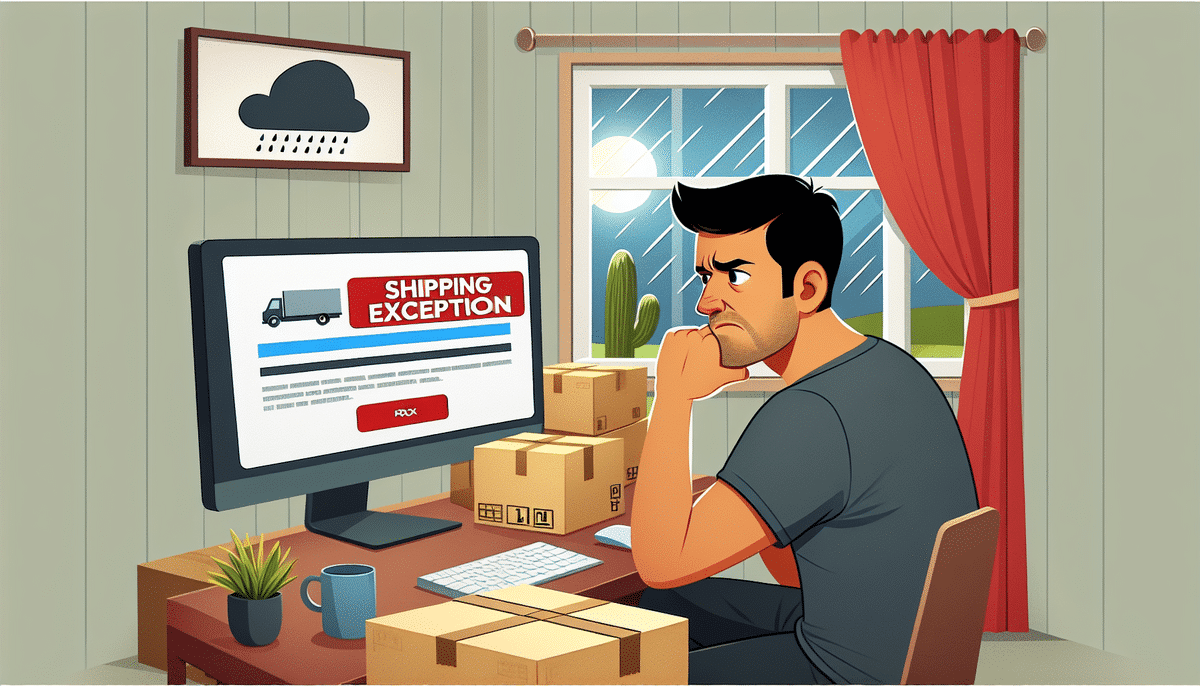Understanding Shipping Exceptions
What is a Shipping Exception?
Shipping exceptions are unexpected events that disrupt the normal delivery process of your package. These exceptions can lead to delays, reroutes, or even returns of your shipment. Recognizing and understanding these exceptions is crucial for effectively managing your deliveries and minimizing inconvenience.
Common Causes of Shipping Exceptions
- Weather Conditions: Extreme weather events like hurricanes, snowstorms, and floods can severely impact transportation routes and delivery schedules.
- Customs Clearance Issues: International shipments may encounter delays due to customs inspections, missing documentation, or regulatory compliance issues.
- Incorrect or Incomplete Information: Errors in the shipping address, missing recipient details, or incorrect contact information can prevent successful delivery.
- Technical Difficulties: System outages, tracking errors, or logistical failures within the carrier's infrastructure can cause unforeseen delays.
- Package Size and Weight: Packages that exceed the carrier's specified size or weight limits may be rejected or require special handling.
- Failed Delivery Attempts: If the recipient is unavailable to receive the package during delivery attempts, it may result in delays or returns.
- Damaged Packages: Physical damage to a package during transit can necessitate inspections or lead to returns to the sender.
The Impact of Shipping Exceptions on Delivery Time
Shipping exceptions can significantly extend the expected delivery time of your package. Carriers strive to adhere to estimated delivery dates, but factors like weather disruptions or incorrect addresses can push these dates back. According to the United States Postal Service (USPS) 2023 Report, weather-related delays account for approximately 15% of all shipping exceptions annually.
Resolving Shipping Exceptions
Steps to Address Common Shipping Exceptions
- Contact the Carrier: Reach out to the carrier's customer service to obtain detailed information about the delay and possible solutions.
- Verify Shipping Information: Double-check the shipping address and recipient details to ensure accuracy.
- Provide Additional Documentation: For issues like customs delays, submitting required paperwork promptly can expedite resolution.
- Arrange for Redelivery or Pickup: If a delivery attempt fails, coordinate a new delivery time or arrange to pick up the package from a local facility.
Filing a Claim for Lost or Damaged Packages
If your package is lost or arrives damaged due to a shipping exception, you may be eligible to file a claim with the carrier. Ensure you have all necessary documentation, such as tracking numbers, photographs of the damage, and proof of value. For detailed guidelines, refer to the FedEx Claims Process, UPS Claims, or the equivalent on other carriers' websites.
Preventing Shipping Exceptions in the Future
Best Practices for Accurate Shipping
- Always double-check the shipping address before confirming an order.
- Use standardized address formats to minimize errors.
- Provide complete recipient information, including contact numbers.
- Ensure packages are adequately labeled and securely packaged to prevent damage.
Choosing Reliable Shipping Carriers
Selecting a reputable shipping carrier with a strong track record can reduce the likelihood of shipping exceptions. Compare carriers based on their delivery performance, customer service quality, and the availability of tracking and insurance options. Resources like the Consumer Reports comparison of shipping carriers can provide valuable insights.
Implementing Robust Order Fulfillment Systems
For e-commerce businesses, having efficient order fulfillment processes is essential to minimize shipping exceptions. This includes accurate inventory management, timely processing of orders, and effective packaging practices to prevent damage during transit.
The Role of Customer Service in Managing Shipping Exceptions
Customer service teams play a pivotal role in handling shipping exceptions. They act as the bridge between the customer and the carrier, providing updates and facilitating solutions. Effective communication and problem-solving skills are essential for customer service representatives to resolve issues promptly and maintain customer satisfaction.
Understanding Carrier Policies and Procedures
Each shipping carrier has its own set of policies and procedures for dealing with shipping exceptions. Familiarize yourself with these guidelines to effectively navigate any issues that arise. Key areas to review include:
- Claim Filing Procedures: Understand the steps and required documentation for filing claims.
- Tracking and Tracing: Learn how to effectively use the carrier's tracking tools to monitor your shipments.
- Insurance Options: Review available insurance plans to protect against loss or damage.
Importance of Communication in Resolving Shipping Exceptions
Effective communication with both the carrier and the recipient is essential when dealing with shipping exceptions. Keep all parties informed about the status and steps being taken to resolve the issue. Clear and respectful communication can expedite the resolution process and enhance overall customer experience.
Best Practices for E-commerce to Handle and Avoid Shipping Exceptions
For online businesses, preventing shipping exceptions is key to maintaining customer satisfaction and operational efficiency. Implement the following best practices:
- Use automated systems to verify shipping addresses and detect potential errors.
- Offer multiple shipping options to accommodate different needs and preferences.
- Provide detailed tracking information to customers to keep them informed.
- Establish a clear return and refund policy to handle any issues swiftly.
By integrating these practices, businesses can reduce the incidence of shipping exceptions and ensure a smoother delivery experience for their customers.






















